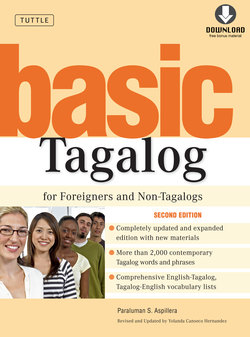Читать книгу Basic Tagalog for Foreigners and Non-Tagalogs - Paraluman S. Aspillera - Страница 8
На сайте Литреса книга снята с продажи.
ОглавлениеPreface to the Revised Edition
More than 500 new words and expressions have been added to this completely updated and expanded version of Basic Tagalog. These are spread throughout the 44 lessons, the Appendices and the exercises as well as in the Tagalog-English/English-Tagalog vocabulary lists at the back of this book. The added vocabulary is meant to keep learners abreast of changes that have occurred in the language since the first edition of Basic Tagalog which was published in 1969.
This edition has retained all the grammar lessons and the tried-and-tested teaching methodology developed by the author, Paraluman S. Aspillera , for the original version. Her method has proven to be extremely effective for tens of thousands of foreigners and non-Tagalogs who have used this book to learn Tagalog, including many who have successfully learned to speak and write Tagalog through self-study on their own without a teacher. An audio CD has also been added to facilitate the correct pronunciation of Tagalog words and phrases. A succinct introduction to the language and a description of the character of Filipinos will hopefully provide learners with a better understanding of the language they are learning.
The lessons in this book are intended for a three-month period of intensive study followed by another three months of applied oral communication of at least two hours per day. In six months (or about 250 hours), it is expected that an average learner should be able to speak, write and understand simple, everyday, conversational Tagalog as spoken by most Filipinos.
I hope that the new and expanded edition of this book will further encourage both non-Tagalogs and non-Filipinos to speak the Tagalog language better. Only then shall they appreciate the individuality of the language that reflects the resilience and flexibility of Filipinos all around the world. In the end, such learning will improve daily interactions and communications between non-Filipinos and Filipinos—whether in business, educational, social or civic endeavors.
Yolanda Canseco Hernandez
